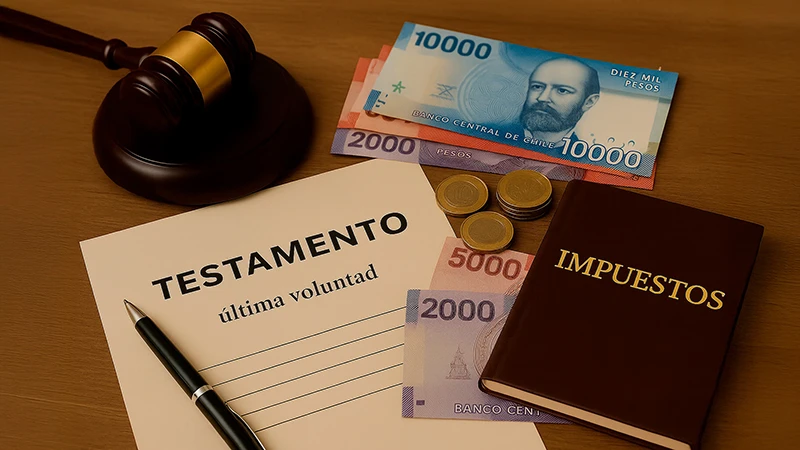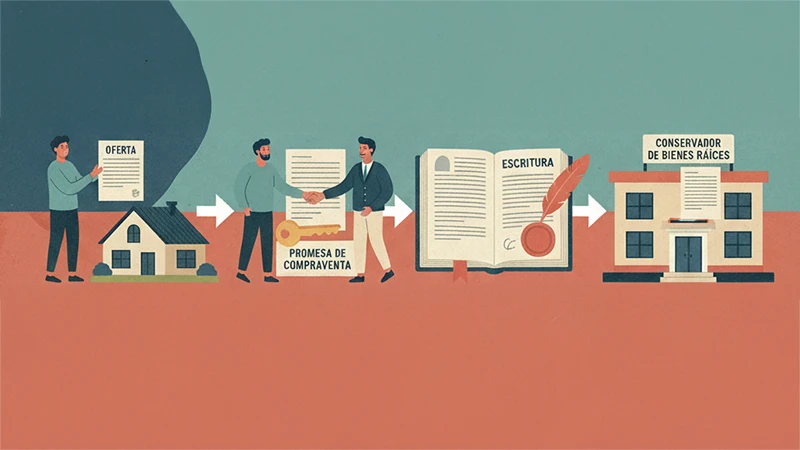The inheritance tax is a tax on the transfer of property due to death (and also on donations). It is regulated by Act No. 16.271 and controlled by the Internal Tax Service (SII). It applies to the liquid value of each hereditary assignment (the amount each heir receives after deduction of expenses and debts). In order to determine this liquid value, the funeral expenses, the succession costs (will publication, albacea fees and party fees, etc.), the hereditary debts, legal alimony and the conjugal portion of the spouse are deducted from the estate. Only the part that exceeds the corresponding deductions and exemptions shall be paid tax. In addition, if an heir receives several assignments in the same inheritance, they are added to calculate their tax base.
The tax is progressive: the rates range from 1% to 25% according to sections defined in Annual Tax Units (UTA). The current official scale is:
Inheritance (UTAs) | Rate |
|---|---|
Up to 80 UTA | 1% |
> 80 to 160 UTA | 2,5% |
> 160 to 320 UTA | 5% |
> 320 to 480 UTA | 7,5% |
> 480 to 640 UTA | 10% |
> 640 to 800 UTA | 15% |
> 800 to 1200 UTA | 20% |
More than 1200 UTA | 25% |
Family allowances
The law grants amounts exempt from tax according to the relationship with the deceased:
- Husband, children and descendants (grandchildren, great-grandchildren, etc.), ascendants (parents, grandparents, etc.): the first 50 UTA of each hereditary assignment are exempt. That is, for each direct heir (spouse, child, father) is not paid in the first 50 UTA of what he receives. In addition, since 2015, recognized civil coexistence has granted the same rights: the “surviving partner” is treated as a spouse.
- Second, third or fourth degree collateral partners (e.g. brothers, half brothers, nephews, uncles, second degree cousins, etc.): the first 5 UTA of the assignment is exempt.
- Other heirs or without kinship: they have no special exemption (beyond the 5 minimum collateral UTA, which in practice do not apply if there is no legal link). For example, an unmarried or civil-living couple (only “de facto couple”) or friends or strangers do not enjoy the 50 UTA of the spouse, so that the total inherited is subject to tax except where appropriate the 5 UTA of collateral (if considered up to 4 ° degree, which is usually not appropriate).
In short: the direct heirs have a minimum free of 50 UTA; the nearby collateral, only 5 UTA. The tax base is calculated on the surplus of these minima.
Recharges by degree of kinship
In addition, the resulting tax is increased (recharge) according to the degree of kinship:
- Direct heirs (spouse, children, parents): no surcharge (surcharge 0%).
- Collateral partners 2nd to 4th grade (brothers, nephews, uncles, carnal cousins, etc.): 20% charge on basic tax.
- More distant or non-kinship partners (e.g. friends, strangers): 40% recharge.
For example, if the basic tax is 10 UTA, a brother (2 ° collateral) would pay 12 UTA in total (10 + 20%), while a friend with no link would pay 14 UTA (10 + 40%). These surcharges are set out in article 2, paragraph 2, of Act No. 16,271.
Time limits for declaring and paying
By law, the declaration and payment of the tax must be made within two years of the date of death of the perpetrator. For example, if the perpetrator dies on 1 March 2024, the tax must be declared and paid before 1 March 2026. The SII provides online forms (Form 4412) to make this declaration.
If it is not paid in time, the debt is adjusted according to the CPI and the interest is applied (1.5% per month). Since March 2020, the tax reform (Act No. 21.210) has made it possible to defer payment by up to three annual contributions payable every 31 December at the request of the taxpayer. If a fee is not paid on time, the heirs must cancel the outstanding amount before 30 March following the deadline.
In practice, the initial step is to obtain effective possession before the Civil Registry (if the succession is inverted) or in courts (if there is a will). Once the heirs (s) have been identified, any of them can submit the statement to the SII online. It should be recalled that all direct heirs (spouse, children and other descendants, ascendants) are legally required to make this declaration when there are transmissible property.
Practical examples of calculation
To illustrate, let’s assume that 1 UTA is approximately $800,000 CLP (value in early 2025). We present three typical cases:
- Low-income (direct beneficiary): A spouse receives a net allowance of 60 UTA. Of this, 50 UTA are exempt (as a spouse). It is taxable 10 UTA, which falls in the tranche of 1%. Tax = 10 UTA × 1% = 0.10 UTA (∞ $80,000 CLP). No surcharge (direct spouse: 0%). Result: pays ~ 0.10 UTA.
- Average (nearby collateral) inheritance: A brother inherits 300 net UTA. Apply 5 UTA (2 ° collateral) exemption, with 295 UTA imposed. The progressive tax on these 295 UTA is calculated:
- 80 UTA at 1% = 0.80 UTA.
- 80 UTA after 2.5% = 2.00 UTA.
- 135 remaining UTA at 5% = 6.75 UTA.
Total basic tax = 0.80 + 2.00 + 6.75 = 9.55 UTA. With 20% recharge (brother = collateral 2 °): final tax = 9,55 × 1,20 = 11,46 UTA. In pesos, if 1 UTA $800,000, it would be $9,168,000 CLP. - High-income (non-kinship): A beneficiary without family relationship inherits 1500 UTA. There are no exemptions (it is not collateral up to 4 °), so everything is taxed:
- 80 UTA × 1% = 0.80 UTA
- 80 UTA × 2.5% = 2.00 UTA
- 160 UTA × 5% = 8,00 UTA
- 160 UTA × 7.5% = 12.00 UTA
- 160 UTA × 10% = 16.00 UTA
- 160 UTA × 15% = 24.00 UTA
- 400 UTA × 20% = 80,00 UTA
- 300 UTA × 25% = 75,00 UTA
Basic tax = 217.80 UTA. With a 40% recharge (without kinship): total tax, namely, 304.92 UTA ($243,936,000 CLP).
These examples show how the tax varies according to amount and kinship. It is always part of the net value of the allocation, subtracting the exempt and then applying the progressive scale plus the corresponding surcharge.
Tips and warnings
- To meet deadlines: Do not wait for the last moment. To declare and pay within 2 years avoids fines and interest. If delayed, it is adjusted according to IPC and moratoriums are added.
- Full inventory: Include all property and debts in effective possession. Omissions can lead to tax claims. Be sure to legally credit funeral expenses, debts and food allowances to deduct them.
- Correct assessment: Declares real values of assets (tax securities, experts, valuations). The II can review assessments (e.g. non-commercial real estate) and adjust taxes if you find substatement. Use official certificates and valid avalanos.
- Exemptions available: Take advantage of the 50 UTA exemption if you are a direct heir (spouse, child, father). Do not assume that all inheritance pays tax; in modest inheritance it can be zero. Also remember the 5 UTA exemption for 2 ° -4 ° collateral. However, do not confuse civil relations: only the registered spouse or civil partner gets 50 exempt UTA; a “de facto couple” without legal registration will be taxed as non-relative (surcharge 40%).
- Property sharing: In succession with several heirs, each assignment is taxed separately. For example, if there are two children, each gets 50 UTA exemption and its individual tax is calculated. Do not divide the hereditary mass before applying exemptions, as the law requires adding the assignments of each heir to impose the tribute.
- Professional advice: Although the article is in simple language, the legal process of succession (effective possession, will, etc.) can be complex. Consider consulting with notary or lawyer for the subsequent procedure, and tax accountants or advisers to optimize the payment of the tax (for example, by planning exemptions or using the quota delay).
- Unmarried couples: If a couple plans to inherit property from each other, evaluate the legalization of civil coexistence or marriage. This is the way to access the 50 UTA exemption and to avoid the 40% surcharge that would apply to a person without legal link (e.g. an unregistered partner or a friend).
In short, the inheritance tax in Chile is progressive and complex, but offers important exemptions for close relatives. To be well informed of the exempted amounts and surcharges avoids surprises: for example, not declaring the 50 UTA exemption for children or spouses would be a common mistake. Take advantage of the official sources (Act 16.271, its regulations and guides of the II) when preparing the declaration, and review these tips to avoid unnecessary fines or overpayments.
How can Produncan Lands help you with the Inheritance Tax?
Facing the death of a loved one is never simple. In addition to this, the complexity of the legal procedures that allow heirs to dispose of the inherited property and to fulfil the corresponding tax obligations is added. In Produncan Lands we understand how difficult this process can be and therefore we offer comprehensive, clear and safe accompaniment.
- We accurately calculate the value of the hereditary mass and the amount of tax applicable according to the sections of Law No. 16.271.
- We identify exemptions, reductions and benefits that they can apply according to the degree of kinship of the heirs.
- We assist in the timely declaration and payment of tax to the Internal Tax Service, avoiding sanctions or interest.
Why choose Produncan Lands?
- Updated knowledge of existing legislation.
- Experience in managing real estate and succession procedures.
- Close collaboration, always looking for clear and efficient solutions.
In Produncan Lands, we are concerned that this process, which is often complex and worn out, becomes a safe and transparent process, allowing the heirs to focus on the most important: honoring the memory of their loved ones and peacefully projecting the future.


